Key Findings
- Conservatories have evolved from traditional Victorian and Edwardian designs to incorporate more minimalist solutions.
- The key to designing the perfect modern-day conservatory lies in balancing materials, roofing, and layout to maximise natural light and airflow.
- Eco-friendly and energy-efficient features are essential for creating a versatile space that meets modern sustainability standards and can be used year-round.
- Popular conservatory styles, such as the Edwardian and Victorian designs, have stood the test of time, while newer designs like the hup! extension offers innovative, quick-to-install solutions.
- At Ken Rhodes, we pride ourselves on offering a vast collection of conservatories, each tailored to meet the unique needs and aesthetic of homeowners throughout Essex and the South East.
The addition of a conservatory extension has long been a popular feature in British homes, offering a perfect space for relaxation, dining, or even gardening.
Over the years, their design and function has evolved from ornate Victorian structures to modern extensions that cater to today’s needs for energy efficiency and a versatile living space.
This blog delves into the history of conservatories, exploring the various styles and key design elements that have shaped their development, before highlighting some of the latest trends and eco-friendly solutions.
A Timeline of Conservatory Styles
Victorian Conservatories: The Age of Ornamentation
The Victorian conservatory, which became a hallmark of 19th-century British architecture, is perhaps the most recognisable of all conservatory designs. Originating during the reign of Queen Victoria (1837-1901), these conservatories were a symbol of wealth and status, often attached to large, stately homes. The design was grand and ornate, typically featuring multi-faceted glazing, steeply pitched roofs, and decorative ridge details. The use of cast iron or wrought iron framing and detailed glazing bars added to the aesthetic further, creating an intricate web of geometric patterns that captured the light.
Visually, Victorian conservatories are known for their curved or angular designs, often with a central projection that creates a rounded or bay window effect. Their unique, organic shapes were intended to provide a sense of light and space, making them perfect for the cultivation of exotic plants and for showcasing collections of orchids or ferns.
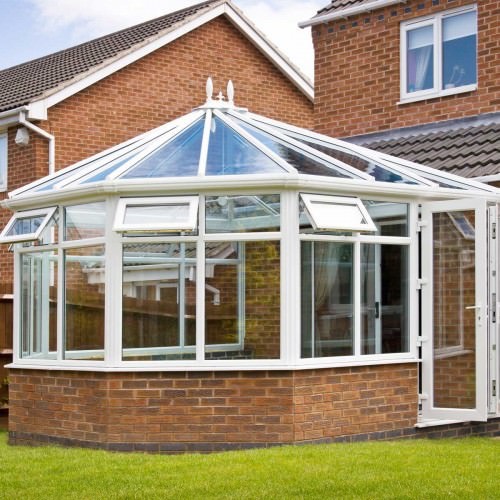
Victorian conservatories are known for their ornate detailing.
Edwardian Conservatories: Function Meets Elegance
In the early 20th century, during the Edwardian period (1901-1910), the design of conservatories shifted towards greater functionality and simplicity while maintaining a sense of elegance. Edwardian conservatories retained the use of high-pitched roofs but moved away from the elaborate detailing of their Victorian predecessors. Instead, they favoured more practical, rectangular or square floor plans, providing better use of space and making them ideal for living or dining areas.
The Edwardian style can be recognised by its clean lines and the focus on symmetry. The high roof pitch created an airy, open space with generous natural light, while the rectangular shape maximised available floor space. This style is often seen in homes built during the early 20th century and remains a popular choice for modern conservatories due to its timeless appeal.
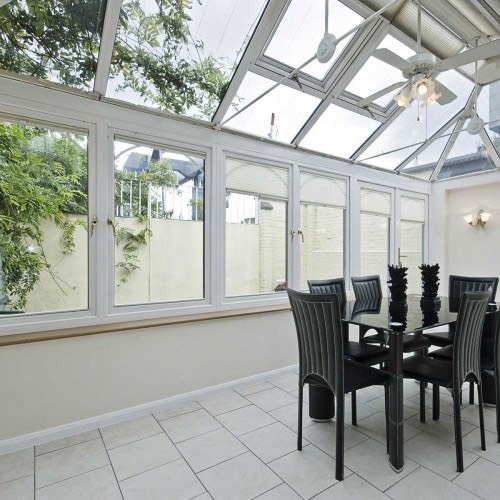
Edwardian conservatories are great for a spacious feel.
Georgian Conservatories: Classical Symmetry
The Georgian period (1714-1830) laid the foundations for a design style that focused on symmetry and proportion. Georgian conservatories, inspired by classical architecture, are characterised by their simple yet elegant design. They feature a rectangular or square floor plan with a gently sloping roof, which is often less steep than that of Victorian or Edwardian style conservatories. The flat-fronted design, with rows of windows across the facade, gives the space a balanced, structured appearance.
These conservatories were typically built as a reflection of the Georgian love for order and balance, with precise geometric shapes and evenly spaced windows. The materials used were often brick, stone, or timber, and glass was typically confined to the roof. The Georgian conservatory style is still revered for its understated charm and its ability to blend seamlessly with both period and contemporary homes.
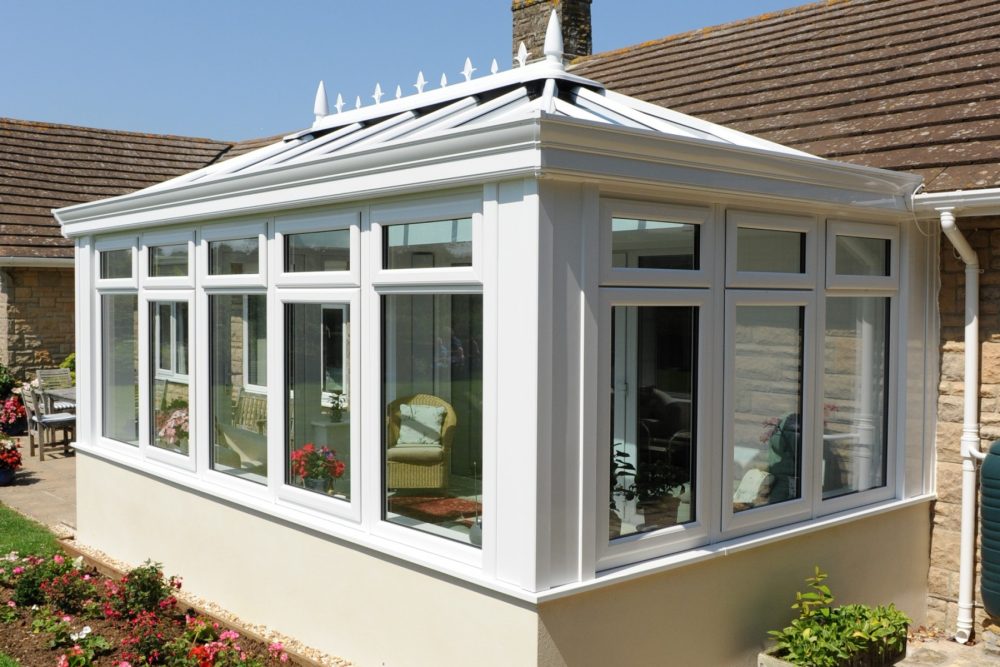
Gable-End Conservatories: A Dramatic Twist
The gable-end conservatory emerged as a design variation of the Georgian conservatory, but with a more dramatic roofline. Instead of a simple, sloping roof, the gable-end features a triangular, gabled roof that creates a sense of height and space. This style of conservatory became popular in the 20th century, particularly for larger homes, as it provided a more striking aesthetic.
Visually, gable-end conservatories are bold and imposing, with their distinctive front-facing triangular roof. The gable design allows for larger windows in the front wall, allowing even more natural light into the space. The style often works well with contemporary architecture, as it provides a more modern alternative to traditional rectangular designs.
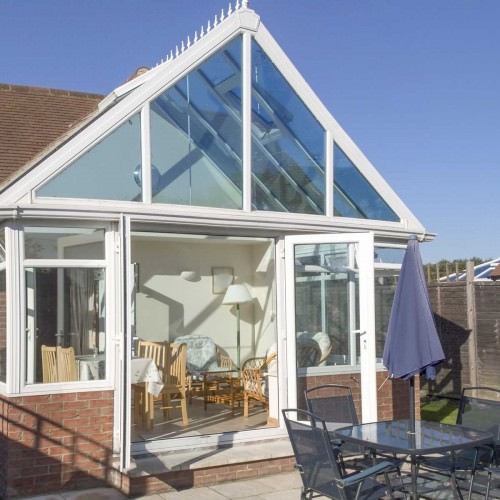
Gable-End conservatories are known for their high-pitched roof.
Lean-To Conservatories: A Simple Solution
The lean-to conservatory, which gained popularity during the 20th century, is the perfect solution for homeowners with limited space or for those looking to add a conservatory to a bungalow or smaller home. Known for its simple, functional design, the lean-to conservatory features a single-sloped roof that leans against an existing wall of the house.
Visually, lean-to conservatories are straightforward and unadorned, with clean lines and a minimalist aesthetic. The roof’s slope allows for ample natural light while maintaining a compact form. Lean-to conservatories are often seen as a more budget-friendly option, offering your home some extra living space without overwhelming the existing structure.

Lean-to conservatories are an effective space-saving solution.
T-Shape and P-Shape Conservatories: Versatile and Expansive
For larger properties, T-shape and P-shape conservatories offer a flexible design solution. Both styles combine the features of multiple conservatory design ideas to create expansive, multifunctional spaces. The T-shape conservatory features a central projection, while the P-shape combines a lean-to with a Victorian or Edwardian design, forming a “P” shape when viewed from above.
These conservatories are perfect for homeowners looking for a larger living space with multiple zones, allowing for everything from dining areas to lounges or even home offices. Visually, T-shape and P-shape conservatories are grand and expansive, often making a bold statement with their intricate rooflines and generous use of glass.
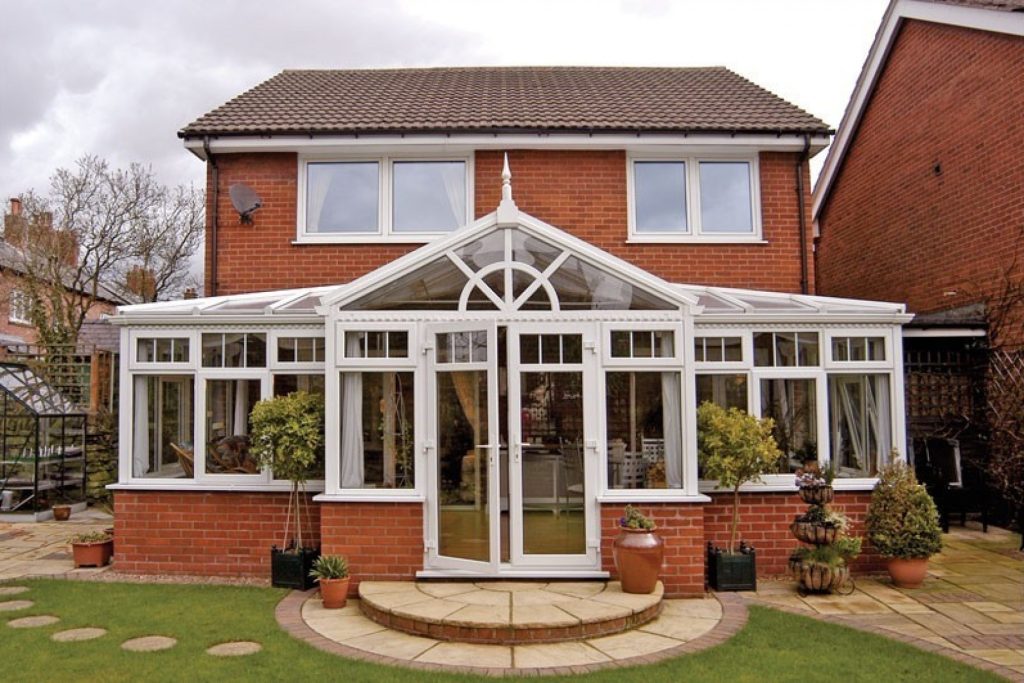
hup! Extensions
In addition to traditional conservatories, the innovative hup! extension system is transforming the way homeowners expand their properties. Designed for energy efficiency, hup! extensions use Ultrapanels that provide outstanding thermal performance, keeping your space cool in summer and warm in winter. These extensions are five times faster to install than traditional builds, and with their sleek, modern design, they offer exceptional flexibility and style. Plus, their high energy efficiency can help reduce your home’s heating costs, making them an eco-friendly alternative to conventional extensions.

Key Design Elements: Materials, Roofing, and Layout
When planning your perfect conservatory, the key to success lies in the materials, roofing, and layout choices you make. These elements not only affect the aesthetic appeal of your conservatory but also play a significant role in its functionality and comfort.
Materials
The materials used in conservatory construction can have a significant impact on the overall look and feel of the space. At Ken Rhodes, we offer a range of materials including uPVC and aluminium to suit different styles and budgets. Whether you want a traditional look or a modern aluminium finish, we can create a bespoke conservatory that complements the beauty of your home.
Roofing
Roofing options are crucial for both aesthetics and performance. Whether you choose a classic glass roof, a Quantal aluminium system, or a LivinRoof hybrid system, each option offers distinct advantages. Glass roofs are perfect for letting in an abundance of natural light, while aluminium and hybrid options offer elite insulation and energy efficiency. For those looking for a more traditional feel, the Ultraroof tiled roof offers a stylish, robust solution.
Layout
The layout of your conservatory will determine how you use the space. Whether you’re looking for an open-plan dining area, a cosy reading nook, or a space for entertaining guests, it’s essential to consider how the layout will work with your existing home. Ensuring that a good amount of light and proper airflow can access the space is key to creating a comfortable and inviting area.
Energy Efficiency and the Future of Conservatories
As sustainability becomes increasingly important, energy-efficient conservatories are in high demand. Modern conservatories are designed with advanced glazing options that help reduce heat loss and improve energy efficiency. At Ken Rhodes, we offer A+ rated double glazing, which ensures your conservatory remains warm in winter and cool in summer.
Additionally, innovative roofing solutions, such as the LivinRoof and Ultraroof, offer superior insulation, while energy-efficient heating systems can help maintain a comfortable temperature year-round. With the right insulation and heating, your conservatory can become an energy-efficient extension of your home, reducing your carbon footprint and lowering energy bills.
Who Are Ken Rhodes?
As a family-run business with over 35 years of experience, at Ken Rhodes we’re dedicated to providing high-quality conservatories, doors, and windows that meet the unique needs of homeowners throughout Essex and the South East.
We offer a wide range of conservatory styles, from classic Victorian and Edwardian designs to modern, energy-efficient extensions like the hup! system.
Our commitment to quality is reflected in our comprehensive 10-year guarantee on all installations, giving you peace of mind that your conservatory will stand the test of time. We are FENSA approved, a Which? Trusted Trader, and Checkatrade approved, ensuring that every project we undertake meets the highest standards.
For more information or to arrange a consultation, contact us today at 01708 227777 or via email at sales@kenrhodes.co.uk. Alternatively, you can visit our showroom in Upminster to see our extensive collection of conservatories and speak with one of our friendly experts.


